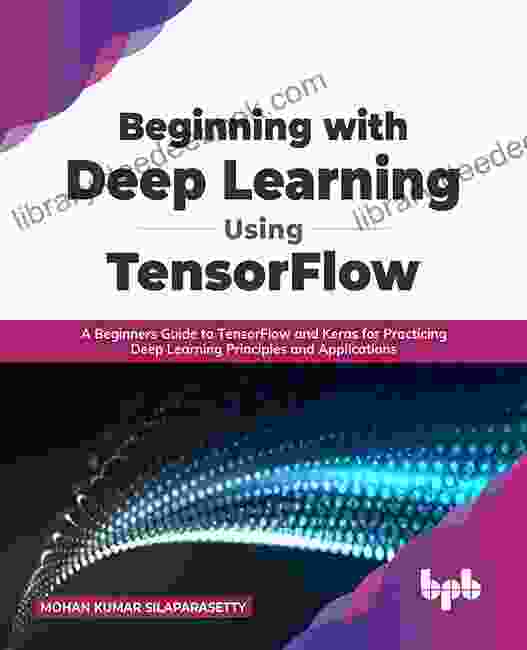Embarking on a Deep Learning Journey with TensorFlow: A Comprehensive Guide for Beginners

In the realm of artificial intelligence, deep learning has emerged as a transformative technology, enabling machines to learn from vast amounts of data and solve complex problems that were previously beyond their reach. TensorFlow, an open-source machine learning library developed by Google, has become a cornerstone of deep learning development, empowering countless researchers, engineers, and enthusiasts to create groundbreaking applications across diverse industries.
5 out of 5
| Language | : | English |
| File size | : | 13528 KB |
| Text-to-Speech | : | Enabled |
| Enhanced typesetting | : | Enabled |
| Screen Reader | : | Supported |
| Print length | : | 372 pages |
This comprehensive guide is meticulously crafted to provide beginners with a solid foundation in deep learning and TensorFlow. We will delve into the fundamental concepts, essential building blocks, and practical implementation steps to equip you with the knowledge and skills necessary to embark on your own deep learning journey.
Understanding Deep Learning
Deep learning is a subfield of machine learning that utilizes artificial neural networks with multiple hidden layers to learn complex relationships within data. These neural networks are loosely inspired by the structure and function of the human brain, enabling them to extract patterns and make predictions from large and complex datasets.
At the core of deep learning lies the concept of representation learning, where the neural network automatically discovers and extracts meaningful features from raw data. This eliminates the need for manual feature engineering, a time-consuming and error-prone task that plagued traditional machine learning approaches.
Key Components of a Neural Network
Neural networks consist of interconnected layers of artificial neurons, each performing a simple mathematical operation on its inputs. These neurons are organized into:
- Input Layer: Receives the raw data and feeds it into the network.
- Hidden Layers: Perform complex computations and feature extraction.
- Output Layer: Generates the network's predictions or outputs.
The neuronsภายในแต่ละเลเยอร์เชื่อมต่อกันโดยมีน้ำหนักที่ปรับได้ น้ำหนักเหล่านี้ควบคุมการไหลของข้อมูลและการเรียนรู้ของเครือข่าย
Types of Neural Networks
There are various types of neural networks, each suited to specific tasks:
- Convolutional Neural Networks (CNNs): Specialized in image recognition and processing.
- Recurrent Neural Networks (RNNs): Handle sequential data, such as text and time series.
- Generative Adversarial Networks (GANs): Create new data that mimics the distribution of the training data.
TensorFlow: A Powerful Tool for Deep Learning
TensorFlow is an extensive open-source machine learning library that provides a comprehensive set of tools and resources for building and training deep learning models. Its user-friendly interface, scalability, and community support make it an ideal choice for both beginners and experienced practitioners.
Key Features of TensorFlow
- Tensor Support: Tensors are multidimensional data structures that form the foundation of deep learning models. TensorFlow seamlessly handles tensor operations, enabling efficient and flexible model development.
- Automatic Differentiation: TensorFlow automates the computation of gradients, a critical step in training neural networks. This simplifies the development and optimization process.
- Cross-Platform Compatibility: TensorFlow runs seamlessly across multiple operating systems and hardware platforms, including CPUs, GPUs, and TPUs, providing flexibility and scalability.
- Extensive Ecosystem: TensorFlow boasts a vast ecosystem of pre-trained models, tutorials, and community support, fostering collaboration and knowledge sharing.
Getting Started with TensorFlow
To begin your deep learning journey with TensorFlow, follow these steps:
- Install TensorFlow: Visit the TensorFlow website to download and install the latest version for your operating system.
- Create a Python Environment: Set up a Python environment using a virtual environment manager like conda or venv to isolate your TensorFlow installation.
- Import TensorFlow: In your Python script, import TensorFlow using the following line:
import tensorflow as tf.
Building Your First Deep Learning Model
Let's delve into building a simple deep learning model using TensorFlow:
import tensorflow as tf # Create a dataset of features and labels features = tf.constant([[1.0, 2.0], [3.0, 4.0], [5.0, 6.0]]) labels = tf.constant([0, 1, 0]) # Define the neural network model model = tf.keras.Sequential([ tf.keras.layers.Dense(units=1, activation='sigmoid') ]) # Compile the model model.compile(optimizer='adam', loss='binary_crossentropy', metrics=['accuracy']) # Train the model model.fit(features, labels, epochs=100) # Evaluate the model model.evaluate(features, labels) # Make predictions predictions = model.predict(features) print(predictions)This code demonstrates how to build a simple binary classification model that predicts whether an input feature belongs to class 0 or 1.
This comprehensive guide has provided you with a solid foundation in deep learning and TensorFlow. You have gained an understanding of the fundamental concepts, essential components of neural networks, and the power of TensorFlow as a tool for deep learning development.
As you continue your journey, remember that practice is key. Experiment with different datasets, model architectures, and optimization techniques to deepen your understanding and develop proficiency in deep learning. The vast resources available online, including tutorials, forums, and documentation, will serve as invaluable companions on your path.
Harnessing the power of deep learning and TensorFlow, you can now embark on your own innovative projects, solve complex problems, and contribute to the advancement of artificial intelligence.
5 out of 5
| Language | : | English |
| File size | : | 13528 KB |
| Text-to-Speech | : | Enabled |
| Enhanced typesetting | : | Enabled |
| Screen Reader | : | Supported |
| Print length | : | 372 pages |
Do you want to contribute by writing guest posts on this blog?
Please contact us and send us a resume of previous articles that you have written.
 Text
Text Genre
Genre Library
Library Newspaper
Newspaper Bookmark
Bookmark Bibliography
Bibliography Foreword
Foreword Footnote
Footnote Manuscript
Manuscript Scroll
Scroll Tome
Tome Bestseller
Bestseller Library card
Library card Autobiography
Autobiography Memoir
Memoir Reference
Reference Encyclopedia
Encyclopedia Thesaurus
Thesaurus Narrator
Narrator Character
Character Resolution
Resolution Librarian
Librarian Catalog
Catalog Stacks
Stacks Archives
Archives Periodicals
Periodicals Study
Study Research
Research Scholarly
Scholarly Reserve
Reserve Academic
Academic Journals
Journals Reading Room
Reading Room Special Collections
Special Collections Interlibrary
Interlibrary Literacy
Literacy Dissertation
Dissertation Storytelling
Storytelling Reading List
Reading List Book Club
Book Club Loren Kajikawa
Loren Kajikawa Barry O Leary
Barry O Leary John Crace
John Crace David Revill
David Revill Marsha Casper Cook
Marsha Casper Cook Willow Fox
Willow Fox Kat Morgenstern
Kat Morgenstern Kevin Heads
Kevin Heads Kate Skinner
Kate Skinner Zarifa Ghafari
Zarifa Ghafari George Orwell
George Orwell Israel Horovitz
Israel Horovitz Ketan Joshi
Ketan Joshi Carrie Stuart Parks
Carrie Stuart Parks Robert Weintraub
Robert Weintraub Barrett Tagliarino
Barrett Tagliarino Liza Bakewell
Liza Bakewell Hyatt Saleh
Hyatt Saleh Bobby Claeys
Bobby Claeys Jennifer Haley
Jennifer Haley
Light bulbAdvertise smarter! Our strategic ad space ensures maximum exposure. Reserve your spot today!

 Gilbert CoxEmbarking on a Deep Learning Journey with TensorFlow: A Comprehensive Guide...
Gilbert CoxEmbarking on a Deep Learning Journey with TensorFlow: A Comprehensive Guide...
 Ian McEwanWonder Woman Pictureback: A Captivating Journey into the Legendary Amazonian...
Ian McEwanWonder Woman Pictureback: A Captivating Journey into the Legendary Amazonian... Harry HayesFollow ·8.9k
Harry HayesFollow ·8.9k Anthony WellsFollow ·8.5k
Anthony WellsFollow ·8.5k Marcel ProustFollow ·5.1k
Marcel ProustFollow ·5.1k Edison MitchellFollow ·3.8k
Edison MitchellFollow ·3.8k Dylan HayesFollow ·6.2k
Dylan HayesFollow ·6.2k Carl WalkerFollow ·9.5k
Carl WalkerFollow ·9.5k Julio CortázarFollow ·2.4k
Julio CortázarFollow ·2.4k Gregory WoodsFollow ·2.8k
Gregory WoodsFollow ·2.8k

 Ralph Ellison
Ralph EllisonHealth Care Global Viewpoints: Samantha Whiskey
Samantha Whiskey is a global health...

 Gabriel Garcia Marquez
Gabriel Garcia MarquezTeacher Educators' Reflections on Culturally Relevant...
In today's...

 Levi Powell
Levi PowellSustainable Project Management: The GPM Reference Guide...
In today's rapidly changing world,...

 Isaac Bell
Isaac BellThe Captivating World of "Dreaming Awake Falling Under"
A Journey Through...

 Clarence Brooks
Clarence BrooksGovernance Regulations Valuations Mergers And...
In today's complex and ever-changing...
5 out of 5
| Language | : | English |
| File size | : | 13528 KB |
| Text-to-Speech | : | Enabled |
| Enhanced typesetting | : | Enabled |
| Screen Reader | : | Supported |
| Print length | : | 372 pages |









